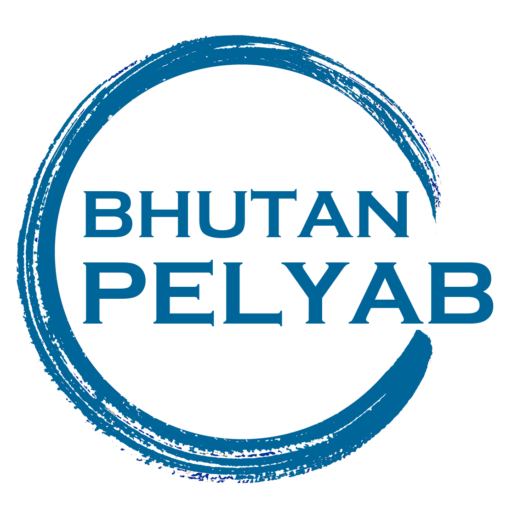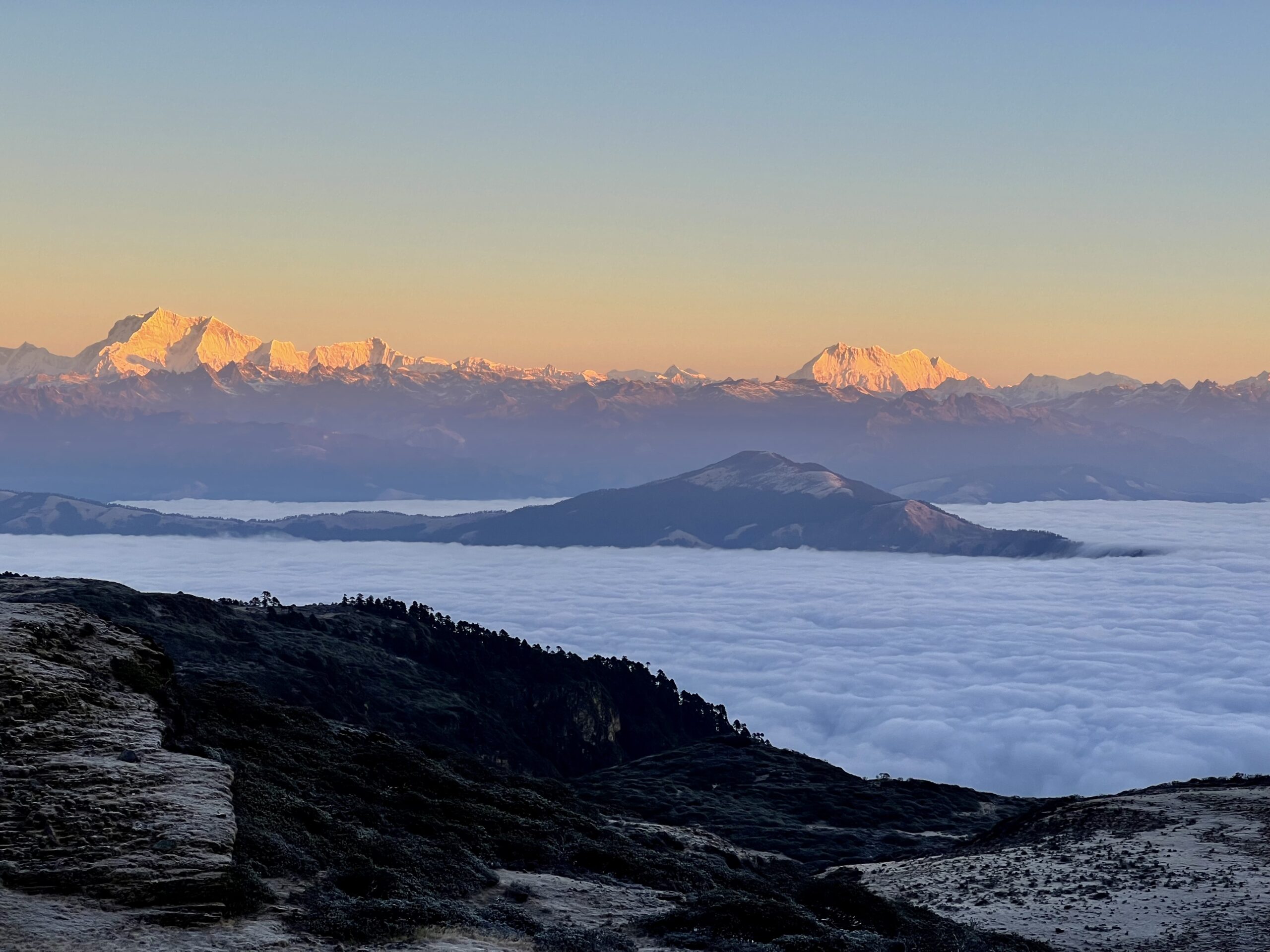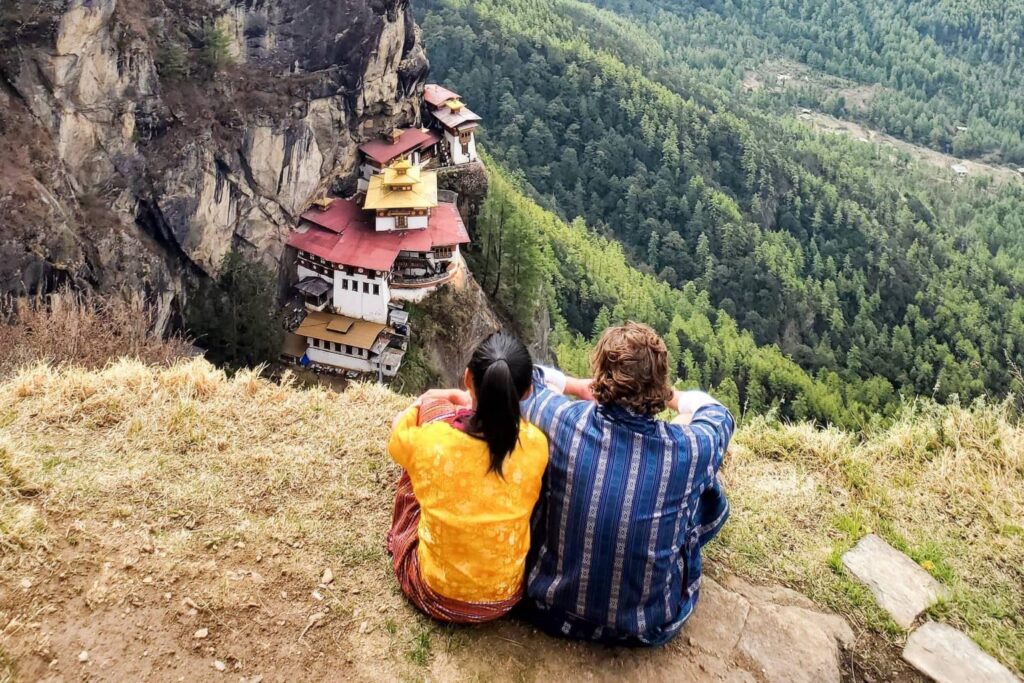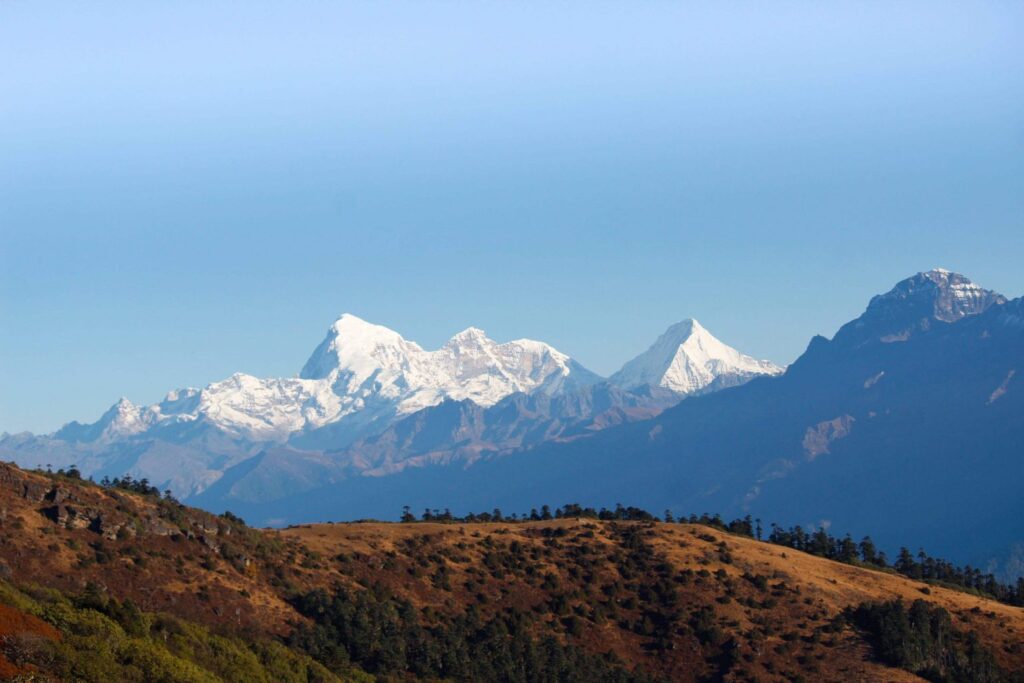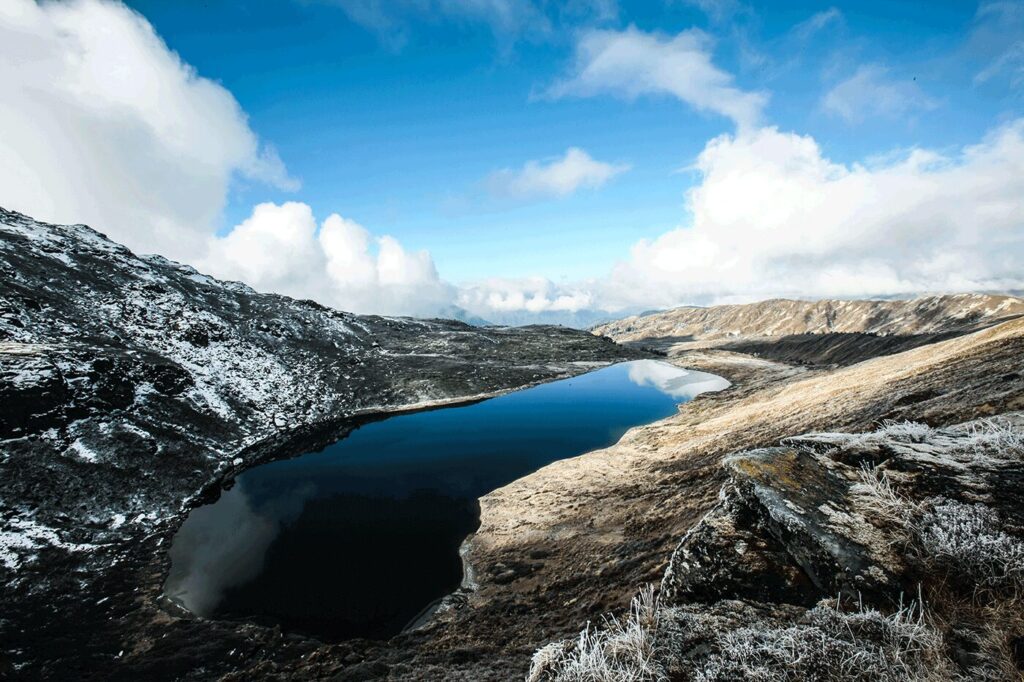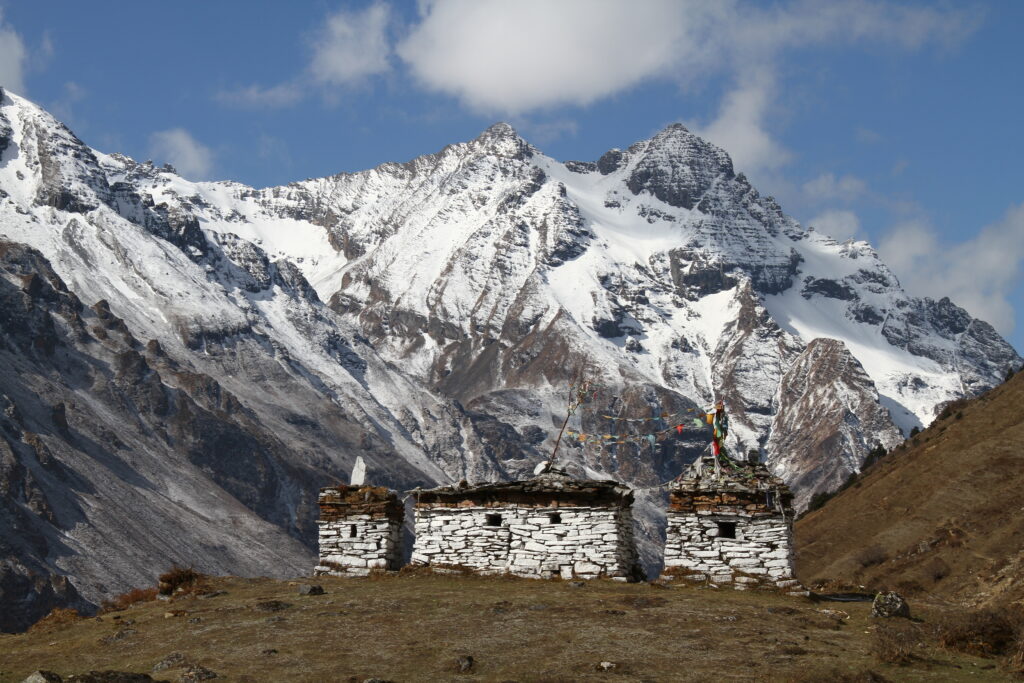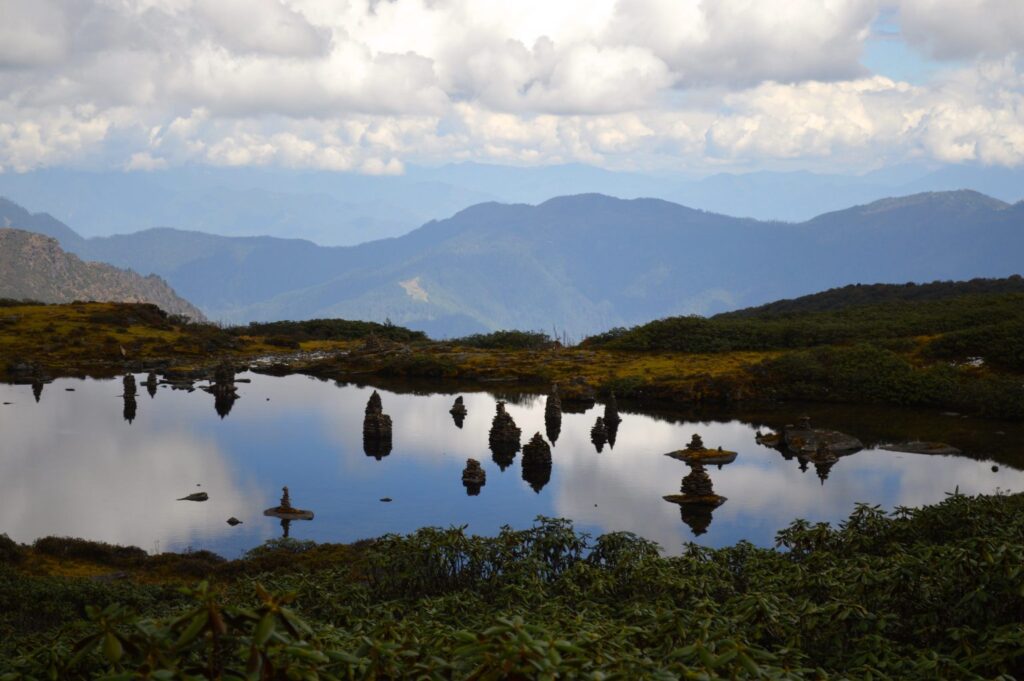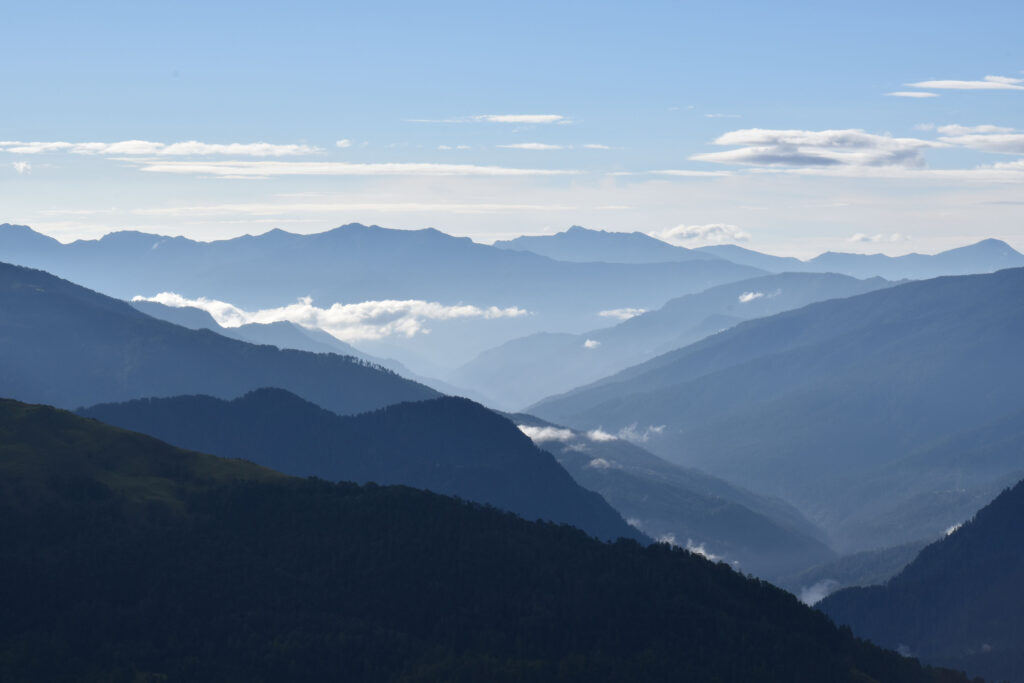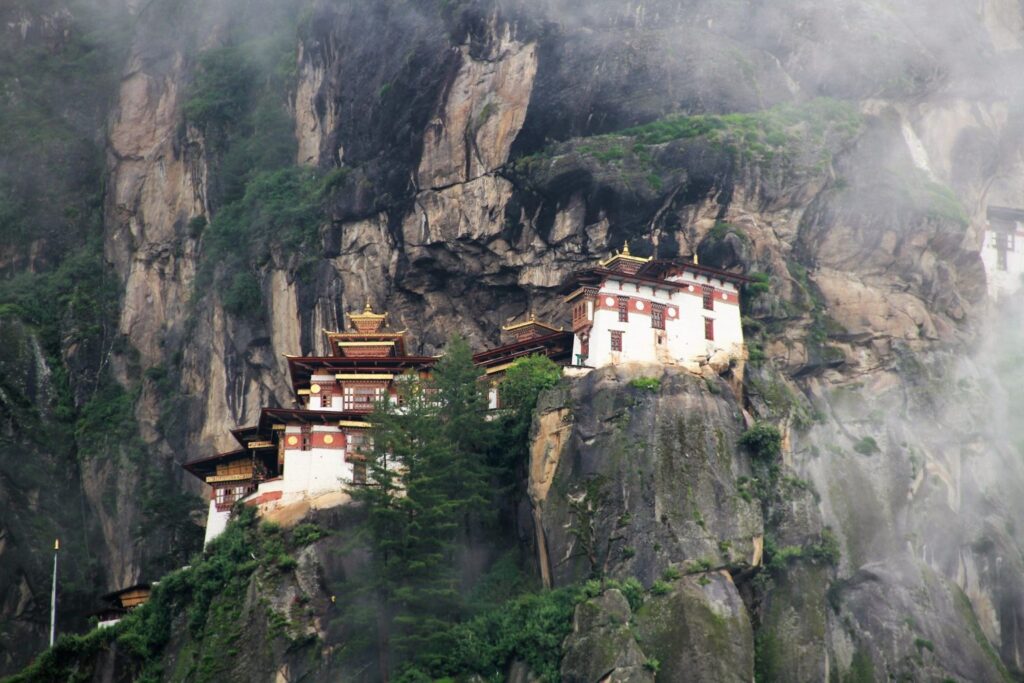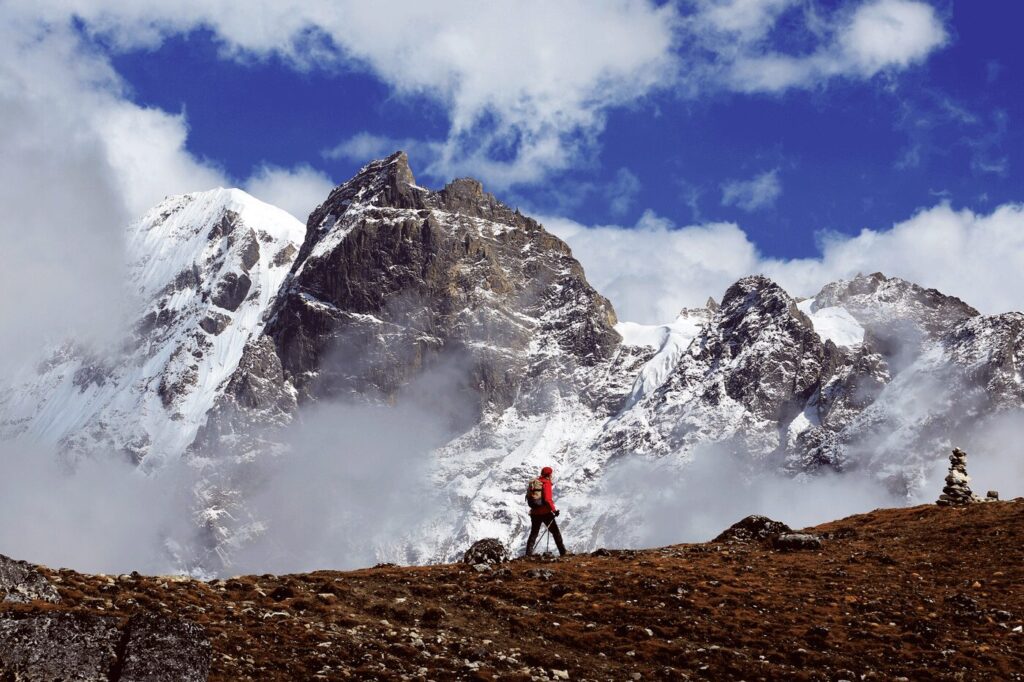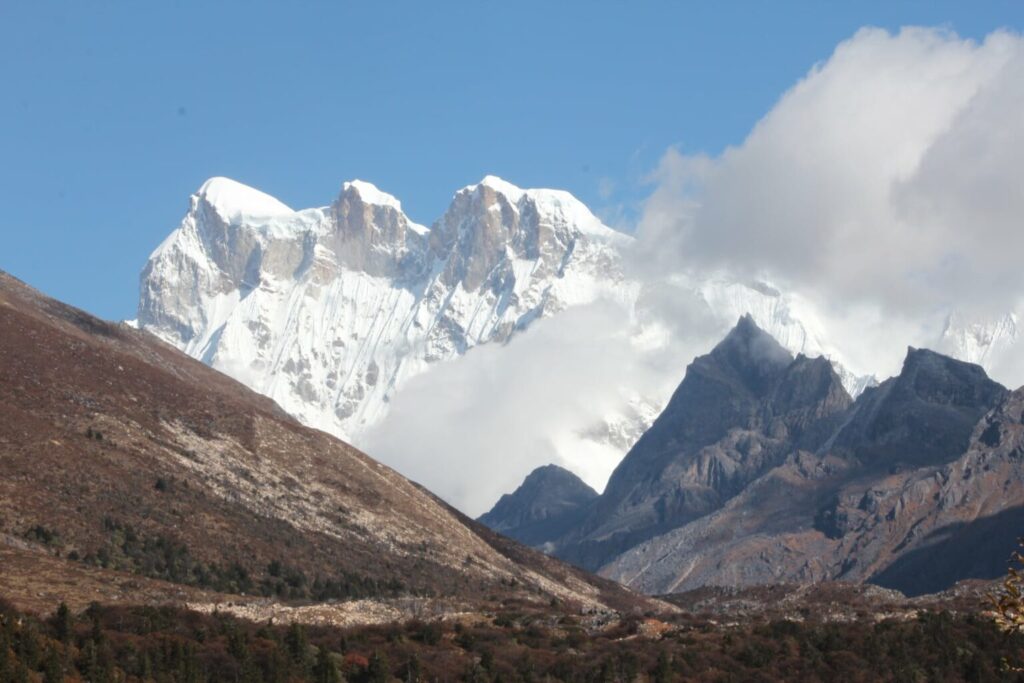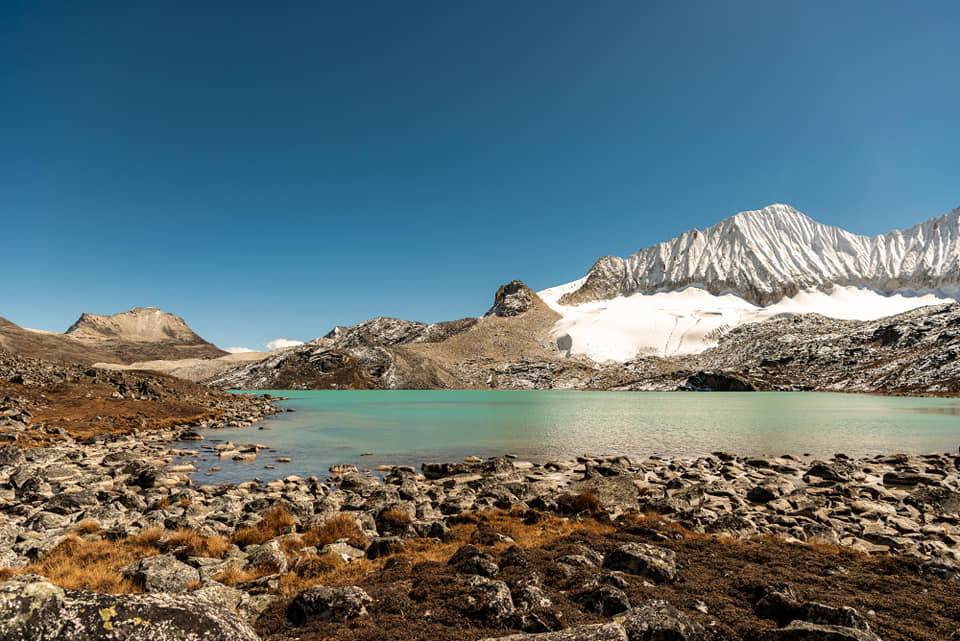Day 1: Arrive in Paro and travel to Thimphu
Welcome to Bhutan and let’s begin an amazing adventure in this magical land!
After arrival at Paro International Airport (2,300m), your guide will drive you to Thimphu (2,400m), Bhutan’s capital, stopping along the way to explore various interesting places. On the way to Thimphu, you will visit Tachogang Lhakhang (Temple of The Excellent Horse). It is located near Chhuzom – the confluence of Paro and Thimphu rivers, known for the serene surroundings. This charming temple was built by Thangtong Gyalpo (1385-1464), a revered figure in Bhutanese tradition. He also built other famous sites and iron bridges across the country.
Once you are at Thimphu, you will feel the dynamic energy of Bhutan’s capital. This bustling tiny city serves as the country’s principal center of trade, religion, and government. Thimphu is Bhutan’s most modern metropolis, with a plethora of restaurants, cafés, nightclubs, and malls. Despite the evidence of modernization, it keeps its cultural identity and values.
After a short rest, you will visit the important place of Thimphu to learn about the capital’s history and culture. Located right near the southern-central part of the city is National Memorial Chorten. It was built in 1974 in memory of the Third King, HM Jigme Dorji Wangchuck and is easily seen from afar with its golden spires and bells. Once you are here, you may watch how Bhutanese do their daily worship.
The Buddha Point, located atop a hill in Kuenselphodrang Nature Park, will be your next stop. This gigantic Shakyamuni statue stands 51.5 meters tall, making it one of the world’s tallest Buddha statues. The statue fulfils an old prophecy uncovered by Terton Pema Lingpa (Religious Treasure Discoverer) dating back to the 8th century A.D. and is claimed to exude an atmosphere of peace and happiness to the world.
The last place to see today is Tashichho Dzong (or Thimphu Dzong). Standing at the north of the city on the west bank of the Wang Chhu, this magnificent dzong dominates the valley, looking out over a waterfall of terraced farms. It is the main secretariat building that houses the King’s offices as well as the Throne Room.
In the evening, don’t miss out on exploring Thimphu’s nightlife. You can walk around or visit local stores to check out their products.
You will stay tonight at the hotel in Thimphu.
Day 2: Thimphu to Punakha
- Altitude in Punakha: 1,300m
- Distance: 75km
- Estimated travel time: 3hrs
Today, you will travel from Thimphu to Punakha. This was Bhutan’s capital until 1952, when Thimphu was selected as the new seat for the government.
On the route, you will stop at Dochula Pass (3,050m), one of Bhutan’s most stunning mountain passes. Here, you will see the 108 “Druk Wangyal Chortens” – built to commemorate the soldiers who died in the war against insurgents from India. From the pass, you will have a panoramic view of the Himalayas with their peaks covered in snow.
The first site to visit in Punakha will be the famous Punakha Dzong (The Palace of Great Happiness), located right at the confluence of Po Chhu and Mo Chhu. Built in 1637 by Ngawang Namgyal, the first Zhabdrung Rinpoche, this is the second-oldest dzong in the country. The dzong is a six-story edifice with a central tower or utse with a spectacular natural setting.
After that, you will go to the Pho Chhu Suspension Bridge, which is not far from Punakha Dzong. It is Bhutan’s longest suspension bridge, measuring 160m in length. Enjoy the serene sight of Punakha Dzong, picturesque valleys and villages as you walk on the bridge.
Final place to explore will be Khamsum Yuelley Namgyal Chorten, known for its unique architecture. The complex is considered a fine example of the art and traditions of Bhutan. Queen Mother Ashi Tshering Yangdon Wangchuck built this chorten for the wellbeing of the whole country and the long life of our beloved King.
You will stay overnight at the hotel in Punakha.
Day 3: Punakha to Gangtey
- Altitude in Gangtay: 2,900m
- Distance: 87km
- Estimated travel time: 3hrs
You will go from Punakha to the scenic Gangtey valley (or Phobjikha valley) in central Bhutan.
First stop at Gangtey will be Gangtey Goemba. Built in 1613, it took the honor as the sole Nyingmapa monastery in the Black Mountain region at the time, and remains the largest one in the western land today. The beautiful views of Gangtey valley with stretches of green fields, virgin forests, and towering mountains are visible from this spectacular building.
Later, join the Gangtey Nature Trail hike. It is a popular and enjoyable hike, especially for those looking to explore the scenery of Gangtey Valley. The pathways will descend from a small mountain top overlooking Gangtey Goemba through magnificent meadows and ultimately to Semchubara hamlet. Following the hamlet, you will be greeted with a dense grove of blue pines. You will undoubtedly love the sensation of being near nature while listening to the little sounds of the forest’s residents.
Continue on till we reach a valley viewpoint. The walk will be completed after we reach Khewang Lhakhang.
Located near to the Khewang Lhakhang is the Black–necked Crane Visitor Centre, also the last visit today. You can learn more about the endangered animal here, and other information regarding flora and fauna, community life and culture of the valley. It is also a great location to spot the Black-necked Cranes and other bird species in the valley.
Tonight, you will stay at the hotel in Gangtey.
Day 4: Gangtey to Bumthang
- Altitude in Bumthang: 2,800m
- Distance: 158km
- Estimated travel time: 6hrs
The travel will take longer today, and you will visit Trongsa, as it lies on the way to Bumthang.
Trongsa is a hilltop town in the center of Bhutan, recognized as the Himalayan Kingdom’s heart. What makes it attractive is that this is where Bhutan’s largest dzong is placed.
Trongsa Dzong is situated strategically, high over the raging Mangde Chhu river. Completed in 1644, the complex is regarded as Bhutan’s most stunning dzong. Trongsa Dzong strikes the attention from afar with its remarkable architecture. The buildings descend the ridge and are linked by a series of alley-like hallways with wide stone staircases. There are nice paved courtyards between the buildings. Trongsa Dzong is so huge that it can be seen from anywhere in town, making it a compelling spectacle for both visitors and locals.
Standing and watching over Trongsa Dzong, Ta Dzong once safeguard the buildings from internal rebellion in the old days. Today, it is the National Museum, with extensive collections relating to the Wangchuck Dynasty. The collections provide visitors with an understanding of the kingdom’s past. The collections are nicely presented, and the items range from ancient treasures to statues of deities.
Then, at the second stop, about 20 kilometers from Chamkhar town, you will walk for about 10 minutes to Trakhar village. The village is situated on a picturesque ridge with the Chume Chu river flowing on its left side and serves as the seat of Pema Lingpa’s son Thukse Dawa Gyeltshen – Guru’s heart son, spiritual son. Pema Lingpa (1450-1521) is one of the most beloved figures of Bhutanese history and one of the most important treasure revealers of the Nyingma lineage of Tibetan Buddhism, in which he is the fourth of the five “kingly treasure revealers.
Here, you will visit Trakhar Lhakhang, built by Thukse Dawa Gyeltshen in the 16th century. It was said that this place was erected by people during the day and by non-human spirits at night. The spirits are claimed to have taken the appearance of monkeys, so the temple was named Trakhar (tra, monkey, and khar, home) – the monkey-built mansion. The people of Trakar village still believe that the lhakhang was built in accord with the prophecy since the presence of white monkeys on the construction site is a good sign.
You will arrive at Bumthang in the late afternoon and stay overnight here.
Day 5: Discover Bumthang
After breakfast, you will attend the well-known Jambay Lhakhang, one of the oldest and most sacred temples established by the 7th-century Tibetan king Songsten Gampo. It is situated along the Chamkhar Chhu on a plateau offering a perfect vibe that comes from both sacred atmosphere and stunningly natural view. Locals believe that the king built the temples in one day to subdue a Tibetan demon, and Jambay Lhakhang was built to pin down her left knee.
Next, you will make a trip to the majestic complex Kurjey Lhakhang. It is located at the end of a paved road. The sacred place is where Guru Rinpoche’s body (kur) print (jey) is kept, in a cave in the complex’s oldest buildings. The temple offers a breathtaking picture of the Bumthang valleys. You can also visit the adjacent apple orchards and dairy farms nearby.
Opposite Kurjey Lhakhang, on the other side of the river is Tamshing Monastery. To get there, you have the option of walking or driving. The walk will take around an hour, however, we highly recommend it if you want to sightsee. The Tamshing Lhendup Chholing (Temple of the Good Message) is Bhutan’s most important Nyingma goemba. The site, founded in 1501 by the great spiritual master Guru Pema Lingpa, was privately owned by his successors until 1960. The building’s distinctive construction was built by Pema Lingpa himself, with the assistance of khandromas who sculpted many of the statues.
Today’s last visit to see will be Lhodrak Kharchu Monastery. It was built by Lama Namkhai Nyingpo Rinpoche and is located on a forested slope overlooking the Chamkhar town. Inside, you can see massive statues of Guru Rinpoche, Chenresig and Sakyamuni.
Tonight, you will stay at the hotel in Bumthang.
Day 06: Hurji village to Phubtsho
- Distance: 6km
- Estimated time: 5-6hrs
- Ascent: 900m
- Camp altitude: 3,500m
Today will mark the first day of the trek. After breakfast, it will take about 30 minutes to get to the trekking spot in Chumey Valley’s Hurji village – where the trek will start.
The trail will lead you through a blue pine forest and up till you reach your first camp site. You have a gradual uphill journey from the starting point till you pass the one magnificent stream river. You will gradually notice how the vegetation changes, from blue pine trees, spruce trees, to towering hemlock trees, and vast rhododendron shrubs.
From the campsite (3,500m) will be a lovely view of Chumey valley with the beautiful Tharpaling monastery, and breathtaking sights of Gangkhar Puensum peak (7,570m), Chomolhari Gang (7,046m), Jitchu Drake (6,989m), Kula Kangri (7,538m) and other Himalaya mountains. You will have more chances to admire the Himalayas throughout your trek.
You will spend the night at the camp.
Day 07: Phubtsho to Khichackpa
- Distance: 10km
- Estimated time: 5-6hrs
- Ascent: 800 m
- Camp altitude: 4,000m
On the second day of the trek, the trail will take you for 2 hours through the hemlock and rhododendron woodland.
Then you’ll emerge from the trees onto higher ground. After one hour of walking, you will come over a lake and another hour before reaching the Rinchen Tsemoi pass (4,300m). From this pass, you will have a 360-degree view of all the Bhutan Himalayan mountains, including Kangchenjunga (8,586 m), the world’s third highest mountain in Skim, India, and Bumthang valley, as well as three lakes surrounding this pass.
Next, you will hike down, flat, up, and down for 1-2 hours from the pass to reach the campsite.
After arriving at the camp, take your time to explore the surrounding views: two lakes, with a view of Dorzing la (black mountain), which Bhutanese regard to be a very mysterious peak in the Trongsa district.
Standing here, you will be rewarded with an amazing sunrise and sunset. Admire the breathtaking views of the majestic Himalayas bathed in golden sunlight. Depending on the weather, you may catch the sight of a sea of clouds and mountain peaks emerging from the “white blanket”.
The Bumthang valley can be seen from the camp location.
Day 8. Khichackpa to Tshemchi
- Distance: 11km
- Estimated time: 7-8hrs
- Ascent: 900m, descent: 700m
- Camp altitude: 4,200m
You will hike up and down roughly 9 km from the camp to reach the Brigdungla pass (4,490m). This is today’s highest pass.
Hike down from the pass to the camp. On the way, you will see several lakes in the distance. These lakes lie between mountains of rocks filled with thorny shrubs.
The highlight of the trek is here since we can appreciate the gorgeous Lhasa Bumpa hill from the tent site. Bhutanese believe the local deity resides at the Lhasa Bumpa hill. If the weather is clear, you can continue to enjoy the views of the Himalayan mountains on your journey.
Day 09: Rest day at Tsemchi
You will have a day-break at Tsemchi, but there will be some light activities. You’ll find yourself near a sacred site revered by the people of Bumthang. Mount Pholha, located at the trail’s highest point of 4,500 meters, is thought to be the abode of a magical energy.
In Bhutan, spirits and deities are believed to exist as supernatural entities in enormous trees, rocks, and mountains. Mount Phola is one such deity worshipped in southern Bumthang.
Mount Phola is a natural wonder. The sight of the mountain, rising from the earth like a fist holding a norbu (valuable jewel), exudes a strong allure that can’t be explained. “No one should climb Phola. Whether it’s a new house or a community rite, we always first pay our respects to Phola.” The majestic mountain is a main attraction on the Brigdungla trek. It is because the landscape here encapsulates everything that the highlands of Bhutan are all about; from the scattered sacred lakes, unique vegetation, incredible views, to the ancient legends and lore that is still close to its people’s hearts.
Day 10: Tsemchi to Wongbu
- Distance: 10km
- Estimated time: 5 – 6hrs
- Ascent: 400m, descent: 600m
- Camp altitude: 4,400m
After saying your goodbyes to Phola, you will begin your four-hour descent to the next camp, Wongbu (4,090m). The path will lead you to a grove of Ballu Sullu bushes. Along the route, you will have a 360-degree panorama of the Himalayas and numerous lakes. Lunch will be served upon reaching Laptsa (4,240m). You can enjoy the meal right next to a lovely stream.
From Laptsa, you will trek to the camping site at Wongbu.
Day 11: Wongbu – Bim village – Jakar town
- Distance 13km
- Estimated time: 5-6hrs
- Ascent 200m, descent: 1,500m
Today’s trail will be a simple one, taking you down to Bim village (2,300m). But for the last trekking day, there will be a special experience waiting for you. You will visit the regions’ last yak herding family. Staying at the bottom of the Wongbu camp hill, they are the only ones who still live a nomadic life until now. Others quitted this lifestyle due to many difficulties, from caring for the yaks to shortage of people helping out.
The path offers beautiful settings of green mountains with herds of yaks and scattered lakes. It will take about 5-6 hours to finally reach Bim village. From here, it will take about 1 hour driving to Chamkhar town.
You will stay at the hotel in Bumthang.
Day 12: Bumthang to Paro by air
After breakfast, we will go to Bathpalathang airport and fly back to Paro. It is a short 35-minute flight.
In Paro, you will begin the exploration with Paro Rinpung Dzong (Fortress of the Heap of Jewels), built on limestone overlooking the valley. This is a magnificent example of Bhutanese architecture with a network of courtyards, temples, offices, and accommodation areas hidden behind towering walls. The courtyard is used for the Paro Tshechu Festival, which takes place on the first day of spring. It is one of Bhutan’s most important celebrations.
The next stop will be the Bhutan National Museum. Once called Ta Dzong, it overlooks Paro Dzong from a hilltop, you can catch the striking view of Paro from here. Turned into a museum in 1968, Ta Dzong’s collection includes antique thangka paintings, swords, armor, and natural and historic relics. It is a key visit to help you learn more about Bhutan, its history and people.
The final site to see today will be Kyichu Lhakhang. The building is situated in Lango Gewog of Paro and is one of Bhutan’s oldest and holiest temples. Kyichu Lhakhang was among the 108 chortens created in the 7th century by Tibetan King Songtsen Gampo to defeat a strong ogress. The main relics are statues of Jowo Jampa (Maitreya) and Sakyamuni.
After returning to town, you will be free to roam around. The town’s nightlife has live music, tasty appetizers, and local booze. Don’t forget to check some of them out.
You will stay in Paro tonight.
Day 13: Paro sightseeing
With a heartfelt breakfast, you will depart to one of Bhutan’s most important and sacred sites – Taktsang Monastery (or Tiger’s Nest). The monastery sits on a precipitous cliff 900m above Paro valley. Because of its unique location, you will need to hike for roughly 3 hours to get here, but your effort will be paid off with a marvelous view of the lush Paro valley and majestic Himalayan mountains.
Legend has it that Guru Rinpoche, riding on the back of a tigress, had landed on a sheer rock and meditated at the very same site and emerged in eight incarnated forms (manifestations). The complex has 4 main temples with golden roofs, 8 caves and several dwellings.
Taktsang monastery will be the last site to visit in Bhutan. In the late afternoon, you will return to the main town for a special meal with a local family. This is an excellent opportunity to meet new people and sample the tasty Bhutanese cuisine. Ema Dashi, red rice, Jasha Maru, and Phaksha Paa are popular traditional dishes in the Bhutanese meals.
You will spend the final night in Paro.
Day 14: Depart Paro
It’s time to say farewell to Paro and the lovely country of Bhutan. We hope that with the assistance of our guide and driver, you have had a great time trip. And we hope to welcome you back to our country one day. Tashi Delek!
